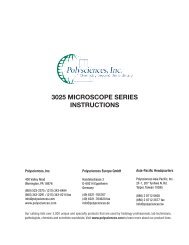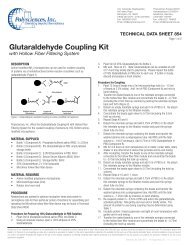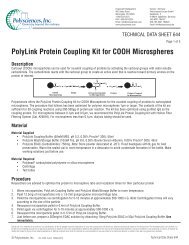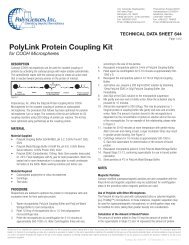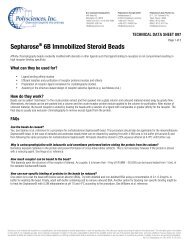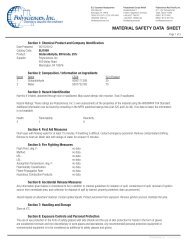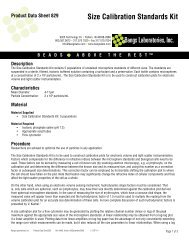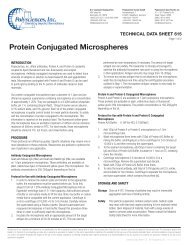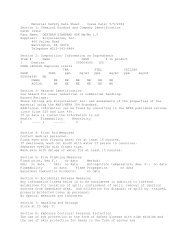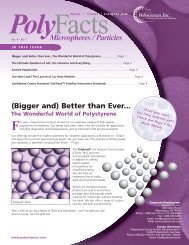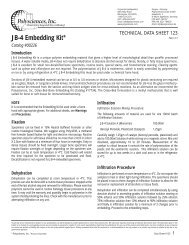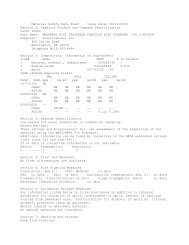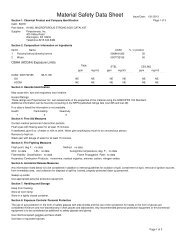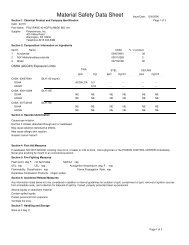BioSciences - Polysciences, Inc.
BioSciences - Polysciences, Inc.
BioSciences - Polysciences, Inc.
Create successful ePaper yourself
Turn your PDF publications into a flip-book with our unique Google optimized e-Paper software.
Electronic Adhesives & Encapsulants<br />
High Performance / Electronic Materials Glossary of Terms<br />
ALPHA-1 & ALPHA-2 (a1 & a2): Alpha 1 is the Coefficient<br />
of Thermal Expansion (see also CTE) below the glass transition<br />
temperature (Tg). Alpha 2 is the CTE above the Tg.<br />
ALPHA EMISSIONS: Are radioactive, high energy particles<br />
that can damage semiconductor devices. Memory devices are<br />
especially sensitive to alpha emission because the passing of the<br />
alpha particle through the device can cause the memory to change<br />
its state from a 1 to a 0 or a 0 to a 1. The device does not fail,<br />
but because the memory now has the wrong value stored, it is<br />
called a soft failure. To avoid such failures, memory devices use<br />
only “low alpha” solder. Low alpha solder contains Lead which has<br />
less radioactivity than normal Lead. Because this low alpha Lead is<br />
scarce, it is more expensive.<br />
ANISOTROPIC: material that has different values when measured<br />
in different directions. Some methods of die connections use<br />
anisotropic conductors, which is a suspension of metal particles in<br />
an adhesive tape or paste. The metal conducts through the tape/<br />
paste (vertically), but not in the plane of the tape (horizontally).<br />
The products are commonly called ACF for film and ACP for paste.<br />
The ACF or ACP is placed on the substrate and the die to be<br />
connected is flipped upside down and pushed into the paste to<br />
make the connections between the chip pads and the substrate<br />
conductors. Sometimes the pads have a gold bump on them to<br />
improve the connection.<br />
BLEEDING: Die Attach adhesives will leak out from under the die<br />
before it is cured. This leakage is called “bleed”. Since wire bonds<br />
will not stick in areas where bleed has occurred it is important<br />
that bleed not exceed a few mils. Bleeding can be controlled<br />
by formulation (filler particle size, resin/hardener selection) and<br />
process (cure temp, out time). In addition, material will bleed<br />
differently on different surfaces (Silver, Nickel, Palladium, solder<br />
mask, polyimide).<br />
CAPILLARY ACTION: The action by which the surface of a liquid<br />
in contact with the walls of a capillary tube or between two closely<br />
spaced plates is drawn into the tube or between the plates by<br />
a wicking action. An example of capillary action is in Flip Chip<br />
assembly, the underfill is dispensed next to the die and the material<br />
is pulled into the gap by the force of capillary action.<br />
CATALYST: A chemical that when added to other materials starts<br />
or speeds up a chemical reaction. The catalyst is not consumed in<br />
the reaction, it only acts to make the reaction take place.<br />
CONDUCTIVITY, ELECTRICAL: How well a material allows<br />
electricity to flow through it. The inverse of conductivity is<br />
resistivity. Most polymers do not conduct electricity, so they have<br />
very low conductivity. To make them conduct electricity we add<br />
metal particles, usually flakes of Silver. In order for the combined<br />
polymer and metal to conduct electricity, the particles must be<br />
close enough to touch.<br />
Table of Electrical Conductivity<br />
Material Resistivity<br />
(Ohm-cm)<br />
10 E-6<br />
Copper (Cu) 1.5<br />
Silver (Ag) 1.5<br />
Gold (Au) 2.0<br />
Aluminum (Al) 2.4<br />
Solder (60/40) 1.5<br />
Die Attach Epoxy 100 to 400<br />
(.0001 to .0004 ohm-cm)<br />
CONDUCTIVITY, THERMAL: How well a material allows heat<br />
to flow through it. Most metals have good thermal conductivity<br />
but ceramic and polymers have poor thermal conductivity. In order<br />
to increase the thermal conductivity of polymers, they need to<br />
be filled with a material that conducts heat well. This can be a<br />
metal (cheapest and best way) but adding a metal will also make<br />
the polymer electrically conductive. To achieve improved thermal<br />
conductivity while allowing the polymer to remain an insulator,<br />
ceramic powders such as Alumina or Aluminum Nitride are added.<br />
The unit of measure of thermal conductivity is Watt/meter-Kelvin.<br />
Table of Thermal Conductivity<br />
Material Thermal Conductivity<br />
(Watts/meter-Kelvin)<br />
Diamond (C) 600<br />
Silver (Ag) 410<br />
Copper (Cu) 390<br />
Gold (Au) 300<br />
Aluminum (Al) 240<br />
Alumina 40<br />
Solder (60/40) 50<br />
Silica 4<br />
Typical Die Attach 1.5 to 2.0<br />
For more information please call (800) 523-2575 or visit: www.polysciences.com 323



